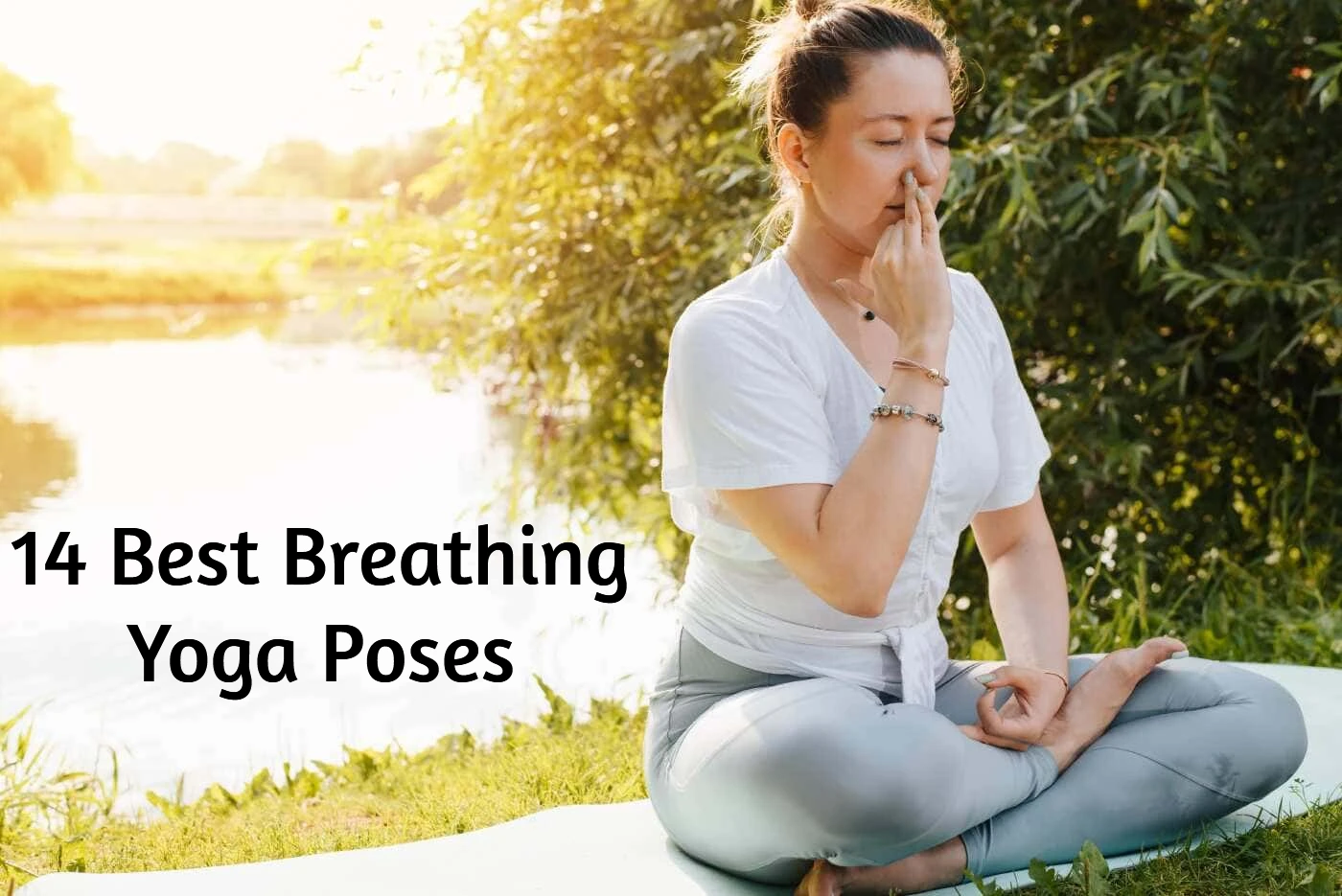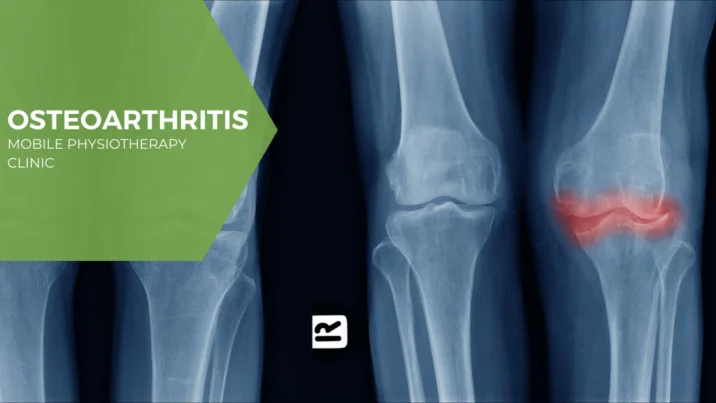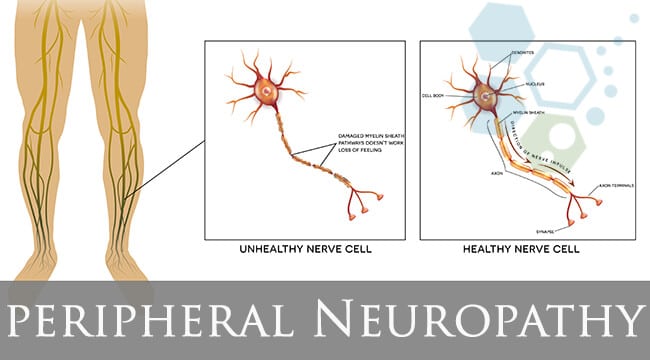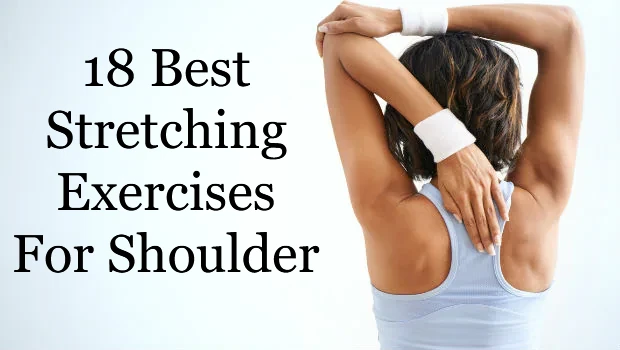14 Best Breathing Yoga Poses
Table of Contents
Introduction
- In yoga, breath is comparable to water in that it is necessary for movement and vitality.
- Think about this adage in Sanskrit: “Because breath is life, and if you breathe well, you will live a long time on earth.”
- However, on the yoga mat, pranayama the fourth of the Eight Limbs of Yoga often receives little attention.
- We don’t need to think about the breath very much because it occurs automatically.
- You may balance the physical, mental, and subtle bodies as well as explore new avenues of exploration and opportunity in your yoga practice by paying attention to your breath.
- According to the book A Life Worth Breathing, pranayama, or breathwork, is the yoga equivalent.
- While there are several methods for teaching students how to breathe in yoga, pranayama is frequently disregarded in favor of asana in studio settings.
- Pranayama, he says, has truly been abandoned.
- Yoga practitioners in antiquity recognized breathwork as an essential and integral component of their practice.
- More prana, or subtle energy, is absorbed in and retained by the body via breath control.
- The first thing we do when we come into this world and the final thing we do when we go out breathes, which is the fundamental core of life.
- Our bodies take in around 500 million breaths in between.
- In addition to being necessary for existence, the mind, body, and breath are inextricably linked and have a profound impact on one another.
- Our mental state affects how we breathe, and our breathing in turn can affect our physiology and thinking.
- Advanced yoga training recommends deep breathing techniques that can benefit our physiology on both a physical and mental level.
- Breathing exercises, or pranayama, have been used for thousands of years in Ayurveda and Yoga to preserve, balance, and restore mental, emotional, spiritual, and physical well-being.
- By regulating breathing, it produces a number of physiological advantages.
- The usefulness of yoga breathing exercises is supported by recent studies.
- According to a 2021 study, those who engaged in breathwork exercises of Sudarshan Kriya Yoga (SKY) reported reduced levels of stress, anxiety, and depression in addition to better sleep.
- The SKY method involves chanting Om while focusing on lengthy exhalations, as well as breathing techniques such as Ujjayi, Bhastrika, and Sudarshan Kriya.
- Evidence that breathwork also reduced symptoms in those with asthma or chronic obstructive pulmonary disease was discovered in a 2020 evaluation of 18 research papers.
- According to previous research, “slow yoga breathing” is crucial for enhancing memory, focus, and other cognitive abilities.
- Here are five transformational yoga breath practices to help you get the most out of your breath work.
- Don’t, however, wait until yoga class.
- These might be useful as you deal with problems in your day-to-day life.
- Particularly in a difficult pose, our innate propensity is to hold our breath or employ stress-induced, shallow breathing when maintaining a posture.
- The body becomes tense and stressed as a result.
- With the deliberate use of breath, yoga aims to develop a peaceful and relaxed body, breath, and mind.
- There are several asana breathing techniques, and they will vary according to the teacher and the tradition.
- I prefer to hold various postures and emphasize various pranayamas (breathing exercises).
- The most crucial thing is to discover a breath that helps you achieve the position and/or invoke the purpose you are using for your yoga practice.
What is Pranayama?
- Prana, which means life energy, and ayama, which means to extend, are the components of pranayama in Sanskrit.
- Consequently, pranayama is the discipline of using the power of breath to manage your prana, or life energy, rather than the practice of breath control itself.
- It’s been stated that breathing is more crucial to a successful physical yoga practice than any position.
- It matters how you breathe when doing yoga.
- Your natural breathing patterns mean that you probably don’t give your breath much thought.
- However, one of the finest things you can do for your mental, physical, and emotional well-being is to pay attention to how you breathe in yoga and in your daily life.
The Connection Between Yoga and Breathing
- We use breath as a meditation object in yoga.
- We intentionally focus on our breath to help us stay in the present moment as we go through the poses.
- This practice can assist us in letting go of tension and bring us into the present moment, which some believe to be the primary purpose of yoga.
- Also, intentionally coordinating our breathing with our movements helps us maintain our posture physiologically.
- Correct breathing techniques help increase your endurance for challenging positions that you would otherwise want to abandon.
The Basics of Breathing During Yoga
- Are you ready to pick up yoga breathing fast? Try these simple steps:
Smooth Your Breath
- Try to make inhales and exhales equally lengthy if you are not striving for any particular energy effect (e.g., purposefully soothing the nervous system or being more alert).
Connect Your Breath to Your Movement
- We are supported in specific postures and motions by the mechanics of our breath.
- For instance, when we perform a backbend, we inhale.
- The backbend alone opens up the chest and upper torso.
- The ribcage expands on inhalation, deepening the backbend.
- Likewise, when we twist, for instance, we want to release our breath.
- We make use of the fact that as we exhale, our navel naturally draws in somewhat, and we combine twists with the expiration.
- This particular dynamic supports the spine while assisting us in twisting deeper.
Take a Breath Before Beginning Your Pose
- One of my favorite teachers teaches his pupils to take a breath before they move and to exhale before they complete a movement.
- The action and the exhalation are the same.
- It may teach you how to connect movement and breath, and it’s a great method to focus your thoughts.
Yoga: Meditation and Breathing
- The majority of people associate yoga with strengthening and extending the body’s range of motion.
- However, many people are unaware of the significance of breathing and meditation in yoga.
- Do you want to control your anger so that you don’t feel like you’re going to lose it all the time?
- Want to manage everything going on in your life with less stress?
- Want to improve your ability to concentrate in class or on your homework?
- Asanas can be beneficial.
- However, breathing exercises and meditation truly complete those advantages.
Meditation and Visualization
- Focus, serenity, and quietness can be attained via meditation.
- It teaches your mind to become calm, relaxed, and optimistic.
- Even when you’re not meditating, even a little daily meditation session may help you feel more in control, centered, and balanced.
- When it feels like you’re being pushed in a million different ways, scheduling meditation as part of your daily routine (just like brushing your teeth) might help you feel more grounded.
- Here are some activities to try with meditation:
Focus on the Breath
- When you come home from educational institutions, try this:
- Find a comfortable spot to relax, shut your door, and set a timer for three to five minutes.
- Shut your eyes and concentrate on your respiration.
- Imagine your ribcage growing, your lungs filling up, and the breath passing through your nasal passages as you inhale.
- Imagine your lungs contracting and your breath shooting out of your nasal passages as you release the breath.
- Say “thinking” to yourself quietly whenever your thoughts stray, and then return your focus to your breathing.
Visualize Success
- When you’re anxious about an impending event, such as a significant test, sporting event, or performance, do this:
- Set a three to five-minute timer.
- Locate a pleasant spot to sit.
- Shut your eyes and see everything running well.
- Imagine yourself taking the test, scoring the game-winning goal in soccer, getting the lead in your theatre audition, or feeling confident and in charge as you sit down.
- Real preparation is still necessary in addition to visualization.
- However, it may support your self-assurance and help you control the negative thoughts that occasionally accompany stress.
Breathing
- One of the most crucial aspects of yoga is breathing.
- You may maximize the benefits of a yoga posture by breathing steadily during the pose.
- However, you may benefit from breathing techniques even when you’re not completing yoga positions.
- Breathing exercises may appear unusual because we breathe automatically every single instant of our lives.
- However, people frequently breathe faster and shallower when they are under stress.
- Observing your breathing patterns may assist you in identifying your emotional state and may even serve as a red flag for stress even if you are not aware of it.
- Thus, begin by observing your breathing patterns, and then concentrate on slowing down and taking deeper breaths.
Try practicing these breathing exercises:
Belly Breathing
- You can concentrate on completely filling your lungs by using belly breathing.
- It’s an excellent method of combating shallow, tense breathing:
- Place one hand on your tummy and sit comfortably.
- Breathe in through your nostrils while keeping your jaw relaxed and your mouth closed.
- Let your tummy grow when you take a breath.
- Envision your lungs filling up from the bottom up, followed by the upper portion.
- Imagine the air leaving your lungs as you gently exhale, and let your belly drop.
- Repeat three times.
- Before a large test, a sporting event, or even before going to bed, this type of breathing might help you relax.
Alternate Nostril Breathing
- Using this breathing method can make you feel calmer and more balanced:
- Choose a comfy spot to sit.
- Put your right hand’s thumb on your right nostril.
- Put down and move your middle and first fingers out of the way.
- Breathe out slowly through your left nostril while counting to five as your right thumb gradually shuts your right nostril.
- Now, while you count to five, softly inhale through your left nostril while maintaining your right thumb on your right nose.
- Elevate your thumb, shut your left nostril with your ring finger, and exhale five times via your right nostril.
- Next, take a slow, deep breath through your right nostril and count to five.
- Return to covering your right nose with your thumb.
- Remove your ring finger from your left nostril and repeat the entire procedure, counting backward five times as you exhale and then counting forward five times as you inhale.
- For three more cycles, repeat this pattern (exhale, inhale, switch sides).
- The benefits of these breathing and meditation practices can be subtle yet potent.
- As you continue to practice them, the advantages will materialize into tangible outcomes.
- This may occur so gradually that you become unaware of it.
How Do I Teach Myself to Breathe?
- Since breathing is a natural and instinctive body function, you perform it around 23,000 times a day whether you realize it or not.
- But by merely paying attention to your breathing, you may enhance and deepen your practice.
- Consider it in two sections: Breathe deeply and slowly through your nose, letting the air fill your lungs and expanding your chest and belly.
- Then slowly release the breath via your nostrils. Repeat.
- That is all there is to breathing.
- You can then proceed to practice various types of pranayama.
Before you start
- Before starting a new workout regimen, it’s crucial to see your doctor if you have heart disease or risk factors for heart disease.
- It is usually good to take some yoga lessons with a certified instructor who can assess your technique if you are new to the practice.
- In case your blood pressure is 180/100 mmHg or more, you shouldn’t exercise yoga.
- If you have heart failure or heart valve problems, you may not be able to perform certain postures.
- Consult your cardiologist or cardiac rehab expert before starting.
- Breathe in and out at a rate that feels comfortable for you to maintain the flow of your breath.
- Breathing too deeply can raise blood pressure, therefore try not to do so.
Brief relaxation in a chair
- Spend some time in silence at the start of your practice.
- Gently close your eyes if it’s comfortable for you to do so, then focus on your breathing.
- Try to breathe in and out via your nose whenever you can, but if that’s not feasible, try breathing out through your mouth.
- Try deepening your breathing and breathing in and out for the same duration of time.
- We call this even breathing.
- Stop the exercise and go back to your normal breathing pattern if you ever find yourself out of breath.
Warm-up – part 1: Mobilising
- Start with a full body warm-up while seated in a chair to make sure all of the body’s major joints are moved through their range of motion.
- Work your way down the body to the ankles, starting at the neck.
- Warm-up exercises can involve various movements such as neck stretches, shoulder rolls, arm curls, wrist circles, upper back flexion and arching, hip circles, knee extension, and ankle circles.
- You should move throughout the warm-up and refrain from standing still for long periods of time.
Second Warm-Up: An Adapted Chair-Based Sun Salutation
- Warming up with the sun salutation is a great stance.
Part One: Anatomy And Breathing Mechanics
The anatomy of breathing
- It is not possible for our lungs to expand and contract on their own.
- The diaphragm, a dome-shaped muscle that separates the chest and abdominal chambers and rests underneath your lungs, is the main force behind respiration.
- Your diaphragm flattens and contracts during inhalation, expanding the capacity of your chest cavity.
- The chest is lifted and expanded simultaneously by the intercostal muscles between the ribs, the pectorals in the chest, the rhomboids and serratus anterior in the upper and mid-back, and the scalenes and sternocleidomastoid in the neck.
- Air is drawn into the lungs by the vacuum created by this combined increase in volume.
- Your diaphragm relaxes during exhalation, decreasing the chest cavity’s volume and raising its pressure.
- Air is forced out of the lungs by the contraction of the intercostals and accessory breathing muscles in the neck, chest, and back as well as by the elastic recoil of the rib cage.
The physiology of breathing
- The autonomic, or involuntary, nervous system controls breathing.
- This implies that we breathe on autopilot, not requiring conscious thought or control.
- But we may also choose to change the rhythm and depth of the breath by tensing and relaxing the previously mentioned auxiliary breathing muscles.
- This sets breathing apart from other physiological functions that are completely uncontrollable by us, such as digestion and circulation.
- Both internal and external conditions have an involuntary impact on the breath.
- When you cross a road without checking both directions, for instance, and have to jump back to prevent getting struck by a car, your respiratory rate quickly increases to help you respond to the situation effectively.
- In reaction to negative emotional states like excitement, desire, surprise, and relaxation as well as negative emotional states like pain, worry, tension, and fear, our breathing cadence and depth alter.
Part Two: How To Breathe In Yoga
- The goal of every yoga class is to leave the practice feeling peaceful and invigorated, not fatigued and depleted.
- Breath is a key component of this.
- We usually begin with a few rounds of centering breathing, go through the sequence of breathing regularly in and out via the nose, and end with a breath-focused meditation.
Breathing In The Centre
- Several rounds of Equal Breathing, or sama vritti as it is known in Sanskrit, are a terrific way to begin your session.
- In this technique, your inhalations and exhalations are of equal duration.
- This calms the body, sharpens the intellect, and strengthens the connection between the two.
- As you progress through the positions, you’ll have more chances to hone your breathing technique, which will get harder.
- Here are a few pointers to remember.
- Stand or sit up straight: A straight spine permits the rib cage to expand and compress in a healthy manner, supported by robust back and abdominal muscles. In the opening position, attempt to maintain a straight spine to avoid restricting the flow of air into and out of your lungs by hunching over and allowing your chest to fall.
- Deepen your breath: Using all of your lung capacity, take calm, deep, and smooth first breaths. Breathe fully through your nose to relax your body and maximize oxygen intake. Release any extra tension in your neck, shoulders, jaw, and throat. Additionally, make an effort to breathe smoothly as you transition between inhalations and exhalations.
- 360° breathing: Breathe deeply into your tummy and let it expand like a balloon. Breathe into your lower back and the sides of your waist simultaneously. Let your rib cage swell from the front, rear, and sides. Be aware of everything around you until the very end of your exhale.
Rhythmic, diaphragmatic breathing
- Maintaining diaphragmatic, deep breathing during a yoga practice and timing it with movement is one of the hardest things to do.
- Generally speaking, when we inhale, our bodies expand and the spine lengthens, and when we exhale, our bodies constrict and the spine rotates. (The sun salutations are when this breathing pattern is most noticeable.)
Maintaining contact with the breath
- The goal is to maintain awareness of the breath during the exercise, but as you have undoubtedly already observed, the mind may easily wander.
- Even if we get off to a great start in class, paying close attention to every inhale and exhalation, eventually our attention wanders due to thoughts or the challenge of the posture and we lose our rhythm.
- This is a very typical occurrence.
- Just softly return your focus to the breath each time you realize you have lost it.
- Regretfully, similar to meditation, mastering this might take years and is tougher than it seems.
Keeping the rhythm
- Whether you are in an advanced posture or a more basic, restorative one, try to keep your nose breathing easy and diaphragmatic.
- Occasionally, things might get so complicated that we forget to breathe or become so tense in a position that we have trouble breathing.
- If you find yourself holding your breath, it may indicate that you’re using too much power and are trying too hard, or it may indicate that you’re in an uncomfortable position, such as a twist, where your breathing mechanism is being compromised.
- Try to slow down and take deeper breaths in both situations.
- Never should you feel overwhelmed or incapable of handling things.
- The neurological system has to relax in order for tension to be released.
- You can estimate the right amount of effort in a way that keeps you safe and attentive by keeping your rhythm consistent.
Extending your exhalations
- When you enter static positions that need more breaths than three or four, you can notice that if you begin to draw out your exhalations, you receive a deeper release.
- The autonomic nervous system is responsible for the minor rise in muscle tension throughout the body during inhalation and the corresponding decrease in tension during exhalation.
- Attempting to force a stretch will set off your body’s natural protective response, which stops the muscle from stretching to prevent injury.
- Similarly, your body will continue to operate in defensive mode if you hold your breath.
- Therefore, relax your belly and begin to lengthen your exhalations as you get into the deeper poses.
Breath-focused meditation
- After your practice, you can fully release your breath control in the Final Resting posture.
- Observe the way your body breathes on its own.
- Try to pay attention to how your body reacts to your breathing.
- Notice how your chest and abdomen rise and fall gently.
- The easy enlargement and reduction.
- For the final few minutes of class, make an effort to maintain your awareness of your breath.
- Consider it as a kind of anchor for the here and now.
- Simply return your focus whenever you become aware of your distraction.
- Thoughts cannot be stopped consciously, but they may be directed and focused on your breathing and let naturally settle.
- In my experience, it’s far simpler to meditate after a yoga class than it is to meditate when seated.
- Your interoception the awareness of what is happening inside your body is sharp, your body is at ease, and there is more mental space between ideas.
- This is an excellent place to start if you want to go deeper into meditation.
Part Three: Practices To Take Off
- In yoga, there are countless advantages to practicing and perfecting your breathing.
- Enhancing lung capacity, raising body awareness, easing discomfort, reducing muscle tension, increasing circulation, and promoting a general sense of lightness and health are all benefits of this practice.
- Nonetheless, there are instances when we must instantly alter our state.
- You’re in “fight or flight” mode if you’re tense, nervous, or in pain.
- Your blood pressure and pulse rate rise, blood glucose levels rise, and you start breathing shallowly and quickly.
- Reproduction and digesting are non-essential tasks that are postponed.
- This could be the best course of action in the near term, but if it continues much longer than the threat, it will probably backfire and possibly even become dangerous.
- The stress chemicals cortisol and adrenaline, as well as the tension in your muscles, continue to rise while your pre-frontal cortex, which is in charge of making decisions and rational thought, shuts down.
- Additionally, your heightened physiology persists in transmitting distress signals to the brain, maintaining a state of “fight or flight.”
Using diaphragmatic breathing to change your state
- In general, equalizing your inhalations and exhalations promotes balance and concentration, prolonging your exhalations calms your nervous system, and prolonging your inhalations makes you feel more alert.
- Since we’re already rather overstimulated, I usually concentrate on the first two of these two breathing techniques, which assist in lowering anxiety and regaining emotional control by activating the parasympathetic, or “rest and digest,” nervous system.
- Depending on what you need right now, you can practice one of these two breathing techniques.
- You may acquire the ability to breathe normally even in highly pressured situations with training.
- Similar to centering breath, make sure your spine is straight, inhale and exhale via your nose, maintain a soft abdomen, pay attention to the breath’s sensations, and attempt to make the transitions between the various phases of breath effortless.
Bringing Yoga Breathing Off the Mat
- Yoga breathing can be done at home or in a class setting.
- For me, the most helpful thing to do in daily life is to just concentrate on and prolong my exhale.
- It’s critical to learn how to reduce your heart rate and relax your nervous system because we live in stressful times.
- Just by taking a few deliberate abdominal breaths and prolonging the exhale, you can accomplish it effortlessly.
- (Akin to the natural lengthening and deepening of ujjayi breathing; maybe a little softer so you don’t scare others around you!) That’s something you can always do, no matter where you are.
- When I want my pupils to calm down and ground themselves, I frequently teach this at the start and finish of class.
- When I want to be more alert, like in the morning or when I’m tired in the afternoon but still need to be productive, I focus on my inhales and Make them as long and as deep as possible.
- If you spread this out over a few minutes, it can have the same impact as an espresso shot!
The Science of How Yoga Poses and Breathing Exercises Promote Deeper Breathing
- Numerous research on the issue has demonstrated that yoga improves fundamental functioning in older individuals with COPD (chronic obstructive pulmonary disease) and reduces asthma episodes in young, healthy persons.
- These illustrations demonstrate how yoga may be an excellent technique for increasing your body’s breathing capacity regardless of your age or level of expertise.
- The practitioners in this research performed specific postures that were selected based on their suitability and the intended therapeutic outcomes.
- We are aware of a few popular yoga poses that emphasize energy.
- For instance, backbends appear to energize and empower, yet hip openers tend to release emotions.
- The postures we focus on are more anatomy-based, to target a particular body function (like improving your breathing, for example).
- This is because breathing can be impeded by tense muscles.
- According to the Department of Physical Medicine and Rehabilitation at The University of Southern California, even a simple issue like bad posture can cause a thirty percent decrease in lung capacity.
- Fortunately, there are yoga positions that focus on opening up the area around the heart and back of the ribs, activating the diaphragm, and employing forceful motions to assist in bringing your attention to the breath.
15 Breathing yoga poses
Following Are The 15 Best Breathing Yoga Poses
Pursed lip breathing
- By requiring you to put purposeful effort into each breath, this easy breathing method causes you to slow down your breathing rate.
- You may always practice breathing with your lips pursed.
- It might be especially helpful while lifting, bending, or climbing stairs.
- To properly master the breathing rhythm, practice utilizing this breath four to five times a day when you first start.
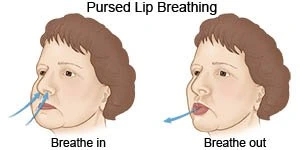
Steps To Follow:
- Your shoulders and neck should be relaxed.
- Breathe in slowly via your nose for two counts while keeping your mouth shut.
- As if you were about to whistle, purse your lips, or pucker them.
- Breathe out gently for four counts while blowing air through your pursed lips.
Diaphragmatic breathing
- Using your diaphragm correctly can be facilitated by diaphragmatic breathing, often known as belly breathing.
- An extremely reputable National Institutes of Health database.
- According to the site, this kind of breathing is especially beneficial for those who have trouble breathing as a result of cancer, cardiac issues, or chronic obstructive pulmonary disease (COPD).
- Additionally, it could lessen stress and assist with issues pertaining to eating disorders, constipation, hypertension, migraines, and other medical ailments.
- Three to four times a day, spend five to ten minutes practicing diaphragmatic breathing.
- You could feel exhausted at first, but with practice, the technique should become more effortless and natural.
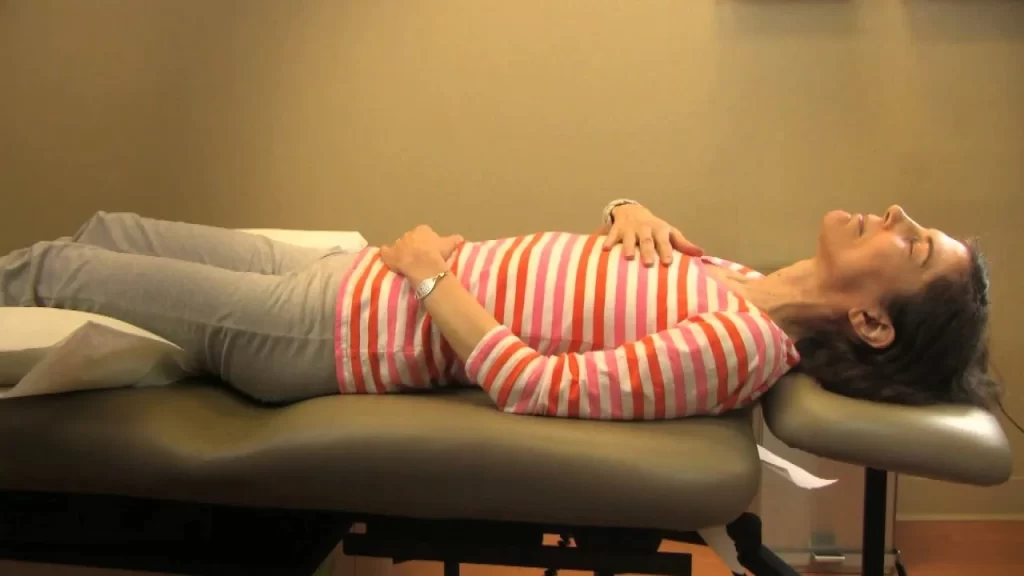
Steps To Follow:
- Head resting on a pillow, position yourself on your back with your knees slightly bent.
- For support, you might tuck a cushion beneath your knees.
- Feel the movement of your diaphragm by placing one hand above your upper chest and one below your rib cage.
- Feel your stomach squeezing against your palm as you take a slow, deep breath through your nose.
- Try to keep the other hand as motionless as you can.
- Keeping your upper hand still, tense your core muscles and exhale through pursed lips.
- For added difficulty, try placing a book on your stomach throughout this workout.
- Once you have mastered the art of belly breathing while lying down, you may attempt it while sitting in a chair to make it more challenging.
- After that, you may put the concept into practice while going about your regular business.
Breath focus technique
- This method of deep breathing makes use of focal words and phrases or imagery.
- You can select a focal word that is neutral, brings you comfort, or makes you grin.
- Peace, let go, and relax are a few examples, but you may choose whatever phrase that works for you to repeat and concentrate on during your practice.
- You might begin with a 10-minute practice as you progress with your breath concentration technique.
- Increase the length of your workouts gradually until they last at least 20 minutes.

Steps To Follow:
- Take a seat or lie down somewhere cozy.
- Bring your awareness to every breath, without trying to change the way you breathe.
- In a sequence of deep and steady breaths, repeat a few times.
- Keep an eye out for any differences in breathing patterns between deep and regular.
- Observe how your abdomen expands when you inhale deeply.
- Note how the sensations of deep and shallow breathing differ.
- Take some time to practice deep breathing.
- Keeping your tummy relaxed, place one hand beneath your belly button and observe how it rises with each inhalation and descends with each exhale.
- Every time you let out a breath, let out a big sigh.
- Combine this deep breathing with visualization and a focus word or phrase that will promote relaxation to start the breath concentration practice.
- You may picture your body experiencing waves of tranquility and serenity as you breathe in.
- Say to yourself, “Inhaling calm and peace.”
- Envision the stress and worry dissipating as the air you breathe.
- Attempt to “let go of the stress and anxiety.”
Alternate nostril breathing
- The Sanskrit term for alternate nostril breathing is Nadi Shodhana Pranayama, and it’s a kind of relaxation breathing.
- It has been demonstrated that breathing via one’s alternate nostrils improves heart health and lowers heart rate.
- It is recommended to practice Nadi Shodhana while you are not eating.
- If you’re feeling under the weather or ill, stay away from the practice.
- Throughout the practice, maintain a steady and smooth breathing pattern.
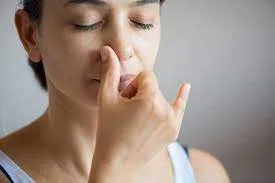
Steps To Follow:
- Choose a sitting posture that is comfy.
- Raise your right hand in the direction of your nose, keeping your other fingers extended while pressing your middle and first fingers down toward your palm.
- After you’ve exhaled, gently close your right nostril with your thumb.
- After inhaling via your left nostril, close it with your right pinky and ring fingers.
- Letting go of your thumb, exhale through your right nose.
- Shut your right nostril after inhaling through it.
- Let go of your fingers and exhale through your left nostril.
- This is one cycle, nothing more.
- Take five minutes or less to breathe in this manner.
- Finally, release your session with a left-side exhale.
Equal breathing
- Equal breathing is known as Sama Vritti in the Sanskrit Language.
- The goal of this breathing method is to equalize the length of your inhales and exhales.
- Calm and balance may be achieved by breathing steadily and smoothly.
- Studies conducted on hypertensive older persons have indicated that this method may enhance mental health and improve oxygen delivery to the brain and lungs.
- A good breath length is one that is neither too easy nor too demanding.
- To keep it going throughout the session, you also don’t want it to be too rapid.
- This is often three to five counts.
- You may practice equal breathing while sitting throughout your yoga practice or other regular tasks after you become used to it.
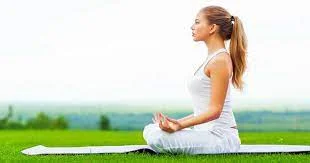
Steps To Follow:
- Choose a sitting posture that is comfy.
- Inhale and exhale through your nostrils.
- Make sure the time of each inhalation and exhalation is equal by counting.
- As an alternative, decide on a word or brief phrase to repeat with each breath in and breath out.
- You might include a little pause for breath retention after each inhale and exhale if it helps you feel better.
- (A normal pause occurs when breathing.)
- For at least five minutes, keep repeating this breathing exercise.
Resonant or coherent breathing
- Breathing five whole breaths per minute is referred to as resonant breathing or coherent breathing.
- This pace may be reached by counting to five while breathing and exhaling.
- In addition to maximizing heart rate variability (HRV) and lowering stress, breathing at this pace has been shown in a 2017 study to potentially lessen depressive symptoms when paired with Iyengar yoga.
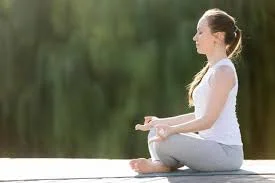
Steps To Follow:
- Breathe in for five counts.
- Breathe out for five counts.
- Maintain this breathing technique for many minutes at a minimum.
Sitali breath
- This breathing technique from yoga helps you de-stress and bring down your body temperature.
- Breathe out slowly and deliberately; do not force it.
- Since Sitali’s breath is inhaled via the mouth, you might wish to practice somewhere free of air pollution and allergies that could bother you.
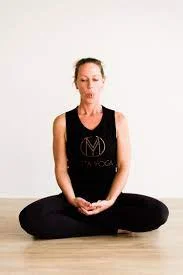
Steps To Follow:
- Choose a sitting posture that is comfy.
- Bring the outside edges together by sticking out and curling your tongue.
- You can purse your lips if your tongue is unable to do this.
- Breathe in through your lips.
- Breathe out using your nose.
- Breathe in this way for no more than five minutes.
Deep breathing
- By allowing air to enter your lungs more easily and allowing you to breathe in cleaner air, deep breathing helps ease shortness of breath.
- It could make you feel calmer and more in control.
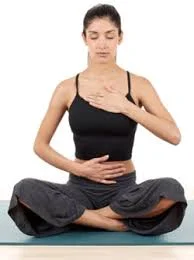
Steps To Follow:
- Raise your elbows slightly to your sides when sitting or standing to make room in your chest.
- Breathe deeply through your nose.
- Hold your breath for five counts.
- Exhale slowly through your nose to release your breath.
Humming bee breath (Bhramari)
- The distinct sensation of this yoga breathing technique is particularly calming over your forehead and aids in quick tranquility.
- Humming bee breath is used by some as a calming technique for tension, rage, and irritation.
- According to research, it may help you feel less anxious or agitated, think more clearly, and lower your heart rate.
- Naturally, you should practice it somewhere that allows you to hum freely.
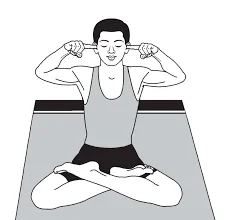
Steps To Follow:
- Choose a sitting posture that is comfy.
- Shut your eyes and ease your facial tension.
- To begin, place your fingers on the portion of your ear canal where the tragus cartilage is partially covered.
- As you breathe, softly push your fingertips into the cartilage.
- Your lips remain closed, but you hum loudly.
- Proceed for as long feels comfortable.
Ujjayi (Ocean Breath Or Victorious Breath)
- In vinyasa-style yoga, ujjayi is the most often practiced breath because it helps you maintain a deep, regular breathing pattern during extended holds and continuous flows.
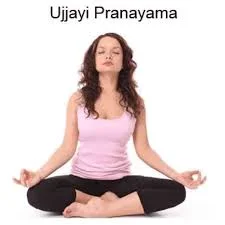
Steps To Follow:
- Breathe deeply through your nose a few times, then out through your mouth in subsequent rounds.
- The next time you exhale, tone the back of your throat like you would if you were fogging a mirror or a pair of glasses a technique also referred to as Darth Vader breath.
- To get the hang of it, practice breathing in through your nose and out through your mouth while using your throat tones a few times.
- Keep your lips shut and release the breath via your nose, keeping the tone of your throat the same as before.
- Continue to tone your throat while breathing after a couple of such rounds.
- Throughout your flow yoga practice, use this breath to focus your energy and maintain equilibrium.
Kapalabhati (Skull Shining Breath)
- Forceful exhalations and passive inhalations make up kapalabhati.
- Start doing it while seated, and stop if you start to feel dizzy.
- As you get more expertise, you may incorporate this breath into an asana pose to provide a little extra fire and intensity.
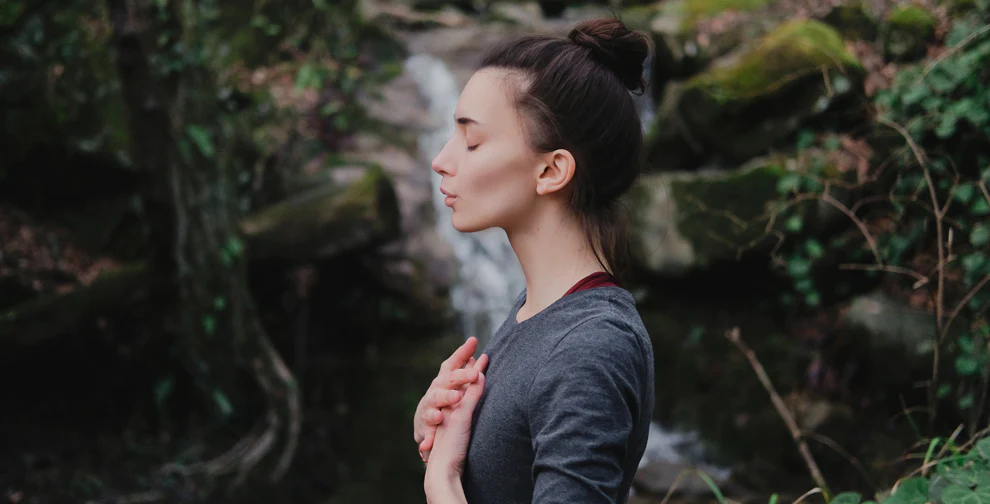
Steps To Follow:
- Start by using your nose to naturally inhale and exhale.
- To begin Kapalabhati, firmly exhale in short, regular bursts through your nostrils.
- To assist in pushing out all the air when you exhale, pull your abdominal muscles towards your spine.
- Allow each breath to come in naturally.
- You will breathe in brief bursts.
- With every exhale, be sure that just the abdomen moves while the head, neck, and shoulders remain neutral.
- Work your way up to around a minute of breathing exercises starting with 20 rounds.
- Kapalabhati may be inserted into practically every static position during asana.
Simhasana (Lion’s Breath)
- A powerful exhale known as “Lion’s Breath” can assist in relieving anxious energy and excess tension.
- It may be performed during asana practice or in a sitting position, as explained below.
- Despite its rather absurd appearance, it’s a great way to decompress.
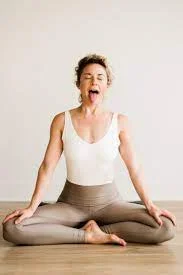
Steps To Follow:
- Assume a kneeling position, placing your palms flat on your thighs and your buttocks resting on your heels (Vajrasana).
- If you find this posture uncomfortable, raise your seat by placing a block or bolster beneath your butt.
- Take a big breath in.
- Take a deep breath out of your widely parted lips, pointing your tongue towards your chin and looking towards your third eye, which is the middle of your forehead where your eyes should be slightly crossed.
- To make a roaring sound, you gently tone down the back of your throat.
Sama Vritti (Equal Breath)
- The body may be brought into equilibrium by breathing in and out at the same time.
- There is a relaxing impact to this steady, deep inhalation.
- It also involves the retention of breath (kumbhaka).
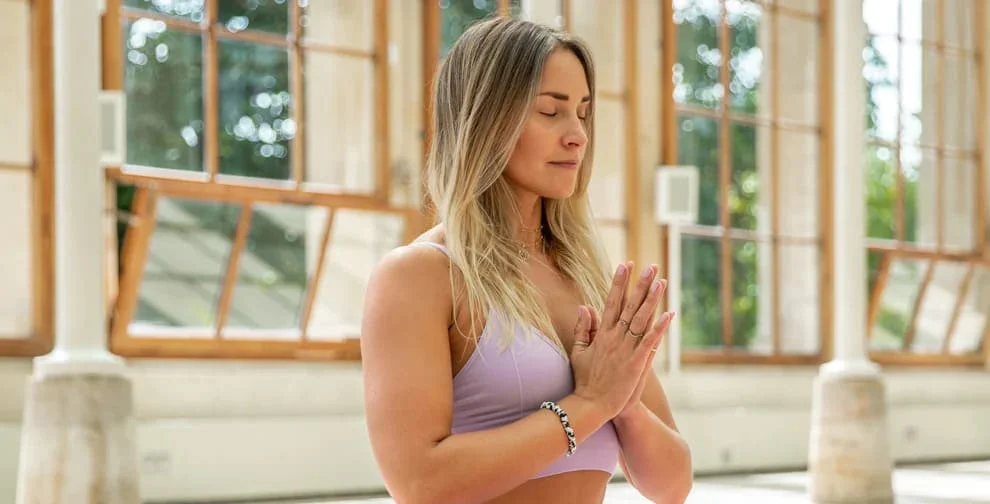
Steps To Follow:
- Take four calm breaths in a row.
- For four counts, hold your breath while filling your lungs to the brim.
- Breathe out four times.
- Hold your breath for four counts when your lungs are empty.
- Continue in this manner for a few minutes.
- For a longer cycle, you can increase the count to six or eight if you’d like.
Nadi Shodhana(Alternate Nostril Breath)
- After a yoga practice, this sitting pranayama is frequently used to calm the body and get it ready for savasana, the pose of rest.
- It is thought to assist in balancing the body’s two sides.
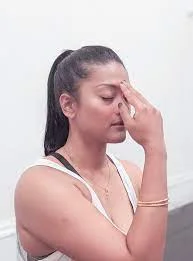
Steps To Follow:
- Assume a comfortable sitting position and place your left hand on your lap.
- Bring your right hand’s middle and forefinger to your forehead’s center, which is your third eye.
- Put your ring finger outside of your left nostril and your thumb outside of your right nostril.
- As you inhale through your left nostril, press your thumb to seal your right nostril.
- As you release your thumb and exhale through your right nostril, press your ring finger to seal your left nostril.
- Breathe in using your right nostril.
- As you release air through your left nostril, press your thumb to shut your right nostril.
- Breathe in using your left nostril.
- This cycle should be continued for a few minutes.
The Benefits of Yoga Breathing
Any combination of yoga breathing techniques you choose has advantages for your body and mind, such as:
- Less overall stress and anxiety
- Improved mindfulness
- Increased lung capacity and blood circulation
- More focus and concentration
Conclusion
The majority of these breathing techniques may be used right away. Spend some time experimenting with various breathing methods. At a minimum, a couple of times a week, set aside a specific amount of time. These are activities that you may perform all day long. If you use medication or have any medical concerns, make an appointment with your doctor. You can speak with a yoga instructor who specializes in breathing techniques or a respiratory therapist if you want additional information about breathing exercises. If at all uncomfortable or agitated sensations arise, stop the practice.
FAQ
Lung Issues: 5 Amazing Yoga Poses To Help With Breathing…
Fish Pose, or Matsya Asana:
Elevate your head and torso, inhale deeply, and then bend your back such that your head’s crown touches the floor.
Breathe deeply while opening your chest. For as long as it seems comfortable, maintain this position for yourself.
The five pranayamas (Nadi Shodhana, Kapalabhati, Bhramari, Ujjayi, and Bhastrika) are practices that are extremely effective in improving one’s general health and well-being.
Six Yoga Breathing Techniques for Stress and Anxiety
Yoga breathing is slower and less spontaneous than regular breathing. With your lips shut, take a few deep breaths in through your nose and then exhale through it for another few seconds. This is meant to collect and concentrate your prana, or energy.
Our findings also point to a number of psychological advantages of pranayama practice, including enhanced emotional reactions, decreased anxiety, weariness, and stress in individuals with cancer and cardiovascular disease.
Tai chi and yoga are two gentle, breathing-based workouts that can help you manage the stress, worry, and despair that sadly sometimes accompany lung illness in addition to improving lung health and capacity.
Just take a big breath.
You may get closer to filling your lungs to the brim with deep breathing. Consciously extend your abdomen while lowering your diaphragm on a slow inhale. Then spread your ribs wide so they open up like wings. Lastly, give the upper chest room to rise and expand.
Reference:
- 5 Pranayama Breathing Exercises for Yoga Beginners. (2023, July 31). Liforme. https://liforme.com/blogs/blog/5-pranayama-breathing-exercises-for-yoga-beginners
- Cronkleton, E. (2023, March 24). 10 Breathing Techniques for Stress Relief and More. Healthline. https://www.healthline.com/health/breathing-exercise#equal-breathing
- Sarani, N. (1970, January 1). I’m a Peloton Yoga and Meditation Instructor and These Are My Favorite Yoga Breathing Methods. https://www.onepeloton.com/blog/yoga-breathing/
- Adele, T. (2021, February 3). Breathe Better With These 6 Yoga Poses and Practices. YouAlignedTM. https://youaligned.com/yoga-breathing-exercises-for-deeper-breathing/
- Y. (2020, November 27). How To Breathe In Yoga: Tips And Practices – Yoga 15. Yoga 15. https://yoga15.com/article/how-to-practice-diaphragmatic-breathing-in-yoga/
- Y. (2020, November 27). How To Breathe In Yoga: Tips And Practices – Yoga 15. Yoga 15. https://yoga15.com/article/how-to-practice-diaphragmatic-breathing-in-yoga/

